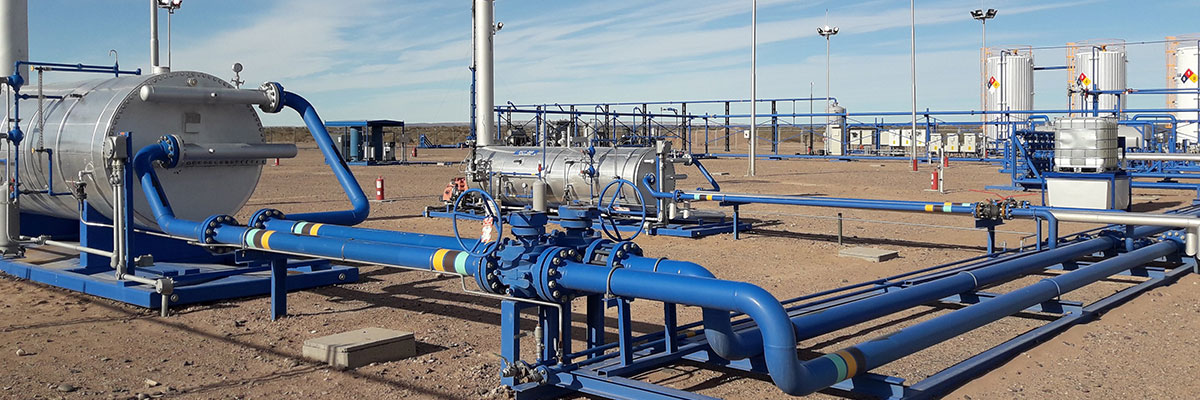Neuquén Basin’s Vaca Muerta
Neuquén Basin’s expansive remoteness and sparse infrastructure make it a good candidate for early production facilities (EPFs). Neuquén Basin is situated on the eastern side of the Andes mountains, straddling the border between Argentina and Chile and encompassing more than 120,000 square kilometers (≈46,300 square miles).[1] As Argentina’s most important hydrocarbon basin, it now meets roughly half of the country’s demand and has enabled Argentina to become a net exporter of oil and natural gas. In a remote landscape of mostly desert, the basin’s operations are primarily based out of the small cities of Plaza Huincul and adjoining Cutral Có, 115 kilometers west of the city of Neuquén and some 1,280 kilometers (800 miles) southwest of Buenos Aires.
Oil was discovered in the basin in 1918, but it’s the more recent unconventional shale activity kicked off in 2010 that has raised the area’s profile, especially the formation called Vaca Muerta, Spanish for ‘Dead Cow’ (presumably because ‘Dinosaurio Muerto’ is not as catchy and easy to say for non-Spanish speakers). Vaca Muerta is of Late Jurassic to Early Cretaceous age and is calculated to hold the world’s second largest deposits of shale oil and gas, with total proven oil reserves estimated to be between 16.2 billion (US EIA) to 22.6 billion (YPF) barrels. The US EIA estimates total recoverable natural gas reserves to be 308 million cubic feet, surpassing that of the basin’s abundant Los Molles formation.[2]


Early Production Facilities in Argentina
An EPF is a relatively compact yet comprehensive skid-mounted system to process oil, gas, and produced water at a pad site. Typically modular, mobile, and rapidly deployable, the solution’s purpose is to bring production online quickly and thereby yield cashflow sooner than with conventional large-scale facilities, while simultaneously obtaining key metrics about the reservoir, fluid composition, sand volume, and flowrate. A modular EPF can be transported to the wellsite, set up, and operational in a matter of weeks.
Case Study: A ‘Booming’ Business Model
When the shale boom began in Neuquén Basin about ten years ago, a major operator engaged TETRA to provide three EPFs for wells tapping into the Vaca Muerta Formation. The goal was to initiate production, prove the viability of the wells, and yield immediate cashflow without a large upfront capital expenditure. The project constituted the first EPFs for unconventional resources in Argentina, and given the limited knowledge of the formation at the time, it would also provide much-needed geophysical data.
The framework of the deal was a business model known as B.O.O.M.—TETRA would build, own, operate, and maintain the plants before the client took ownership of them. Each of the plants was constructed one after the other over a period of three years.
Later, the second plant was disassembled, relocated, reassembled, and operational with unprecedented rapidity—a task accelerated by the modularity of the TETRA components. The relocation of the second facility meant the overall project amounted to essentially building four plants with the materials for three.
Ultimately, the fully engineered modular design of the TETRA equipment enabled the rapid assembly of all three facilities, as well as making possible the quick relocation of the second plant. Each facility was first assembled and operational in less than eight months, while the relocation and reassembly of the second facility took just five months. The efficiency of the project ultimately saved the client valuable time and greatly reduced the risk that would have otherwise come with a lengthy construction project.
Raising Value, Reducing Risk
The operator assumed ownership of all three facilities after five years of demonstrated performance and reliability. Each facility currently processes about 300,000 cubic meters of natural gas per day and about 1,000 cubic meters of liquid per day—combined totals of 900,000 m3 of gas and 3,000 m3 of liquid per day. Additionally, the TETRA equipment isolates the high volumes of sand and associated gas from the flowstream with exceptional efficiency, preventing damage to the production facilities and yielding valuable natural gas for delivery to the market.
For the client, the principal benefit of the EPFs was having the capability to achieve profitable production targets and early cashflow within a short timeframe, yet without having to invest a prohibitive amount of capital upfront. The EPFs eliminated the client’s investment uncertainty, while TETRA shouldered the burden of project risk and proved the performance of the facilities over a modest period of time.
A Landscape Made for EPFs
Taking the long view, unconventional activity in Neuquén Basin is just getting started. Argentina is likely to see development exponentially rise in the basin over the next few years. With that rise, and due to the region’s considerable remoteness and minimal infrastructure, early production facilities—whether minimal or comprehensive in scope—will no doubt continue to play a vital role in the region. Coupled with the B.O.O.M. business model, EPFs are a sound investment strategy for the future of Argentina’s energy demand.
[1] J. Howell et al., 2005, “The Neuquén Basin: An Overview,” in G.D. Viega et al, The Neuquén Basin, Argentina: A Case Study in Sequence Stratigraphy and Basin Dynamics, The Geological Society of London, 2005, pp. 1–14.
[2] U.S. Energy Information Administration, 2019, “Growth in Argentina’s Vaca Muerta Shale and Tight Gas Production Leads to LNG Exports,” July 12; “Vaca Muerta,” Wikipedia; See also U.S. EIA’s report “Technically Recoverable Shale Oil and Shale Gas Resources: An Assessment of 137 Shale Formations in 41 Countries Outside the United States,” June 2013.



